SpringBoot自动配置源码解析+自定义Spring Boot Starter
@SpringBootApplication
Spring Boot应用标注 @SpringBootApplication 注解的类说明该类是Spring Boot 的主配置类,需要运行该类的main方法进行启动 Spring Boot 应用

@SpringBootConfiguration
该注解标注表示标注的类是个配置类
@EnableAutoConfiguration
直译:开启自动配置
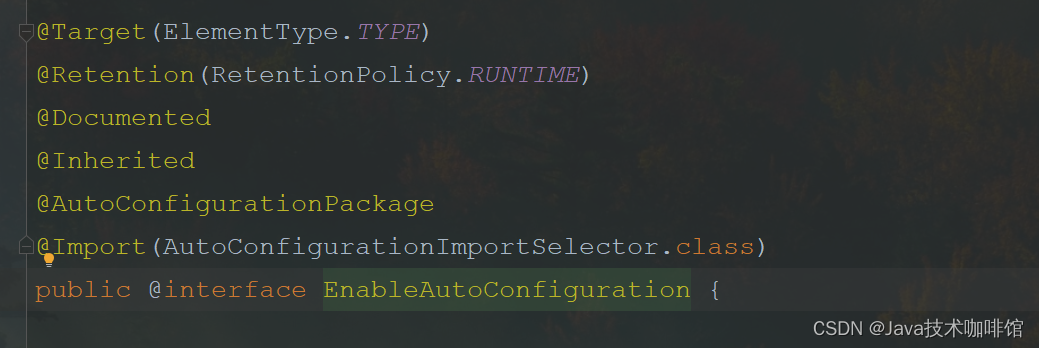
@AutoConfigurationPackage
将当前配置类所在的包保存在 basePackages 的Bean 中,提供给Spring 使用

@Import(AutoConfigurationPackages.Registrar.class)
注册一个保存当前配置类所在包的Bean
@Import(AutoConfigurationImportSelector.class)
使用@Import注解完成导入AutoConfigurationImportSelector类 的功能。AutoConfigurationImportSelector 实现了DeferredImportSelector类
注:在解析ImportSelector时,所导入的配置类会被直接解析,而DeferredImportSelector导入的配置类会延迟进行解析(延迟在其他配置类都解析完之后)
 Spring容器在解析@Import时会去执行DeferredImportSelector 的 selectImports方法:
Spring容器在解析@Import时会去执行DeferredImportSelector 的 selectImports方法:
/*** Return the {@link AutoConfigurationEntry} based on the {@link AnnotationMetadata}* of the importing {@link Configuration @Configuration} class.* @param annotationMetadata the annotation metadata of the configuration class* @return the auto-configurations that should be imported*/protected AutoConfigurationEntry getAutoConfigurationEntry(AnnotationMetadata annotationMetadata) {if (!isEnabled(annotationMetadata)) {return EMPTY_ENTRY;}AnnotationAttributes attributes = getAttributes(annotationMetadata);// 从META-INF/spring.factories中获得候选的自动配置类List<String> configurations = getCandidateConfigurations(annotationMetadata, attributes);//去重configurations = removeDuplicates(configurations);//根据EnableAutoConfiguration注解中exclude、excludeName属性、//spring.autoconfigure.exclude 配置的排除项Set<String> exclusions = getExclusions(annotationMetadata, attributes);checkExcludedClasses(configurations, exclusions);configurations.removeAll(exclusions);// 通过读取spring.factories 中 // OnBeanCondition\OnClassCondition\OnWebApplicationCondition进行过滤configurations = getConfigurationClassFilter().filter(configurations);fireAutoConfigurationImportEvents(configurations, exclusions);return new AutoConfigurationEntry(configurations, exclusions);}springboot应用中都会引入spring-boot-autoconfigure依赖,spring.factories文件就在该包的META-INF下面。spring.factories文件是Key=Value形式,多个Value时使用“,”逗号进行分割,该文件中定义了关于初始化、监听器、过滤器等信息,而真正使自动配置生效的key是org.springframework.boot.autoconfigure.EnableAutoConfiguration,如下所示:
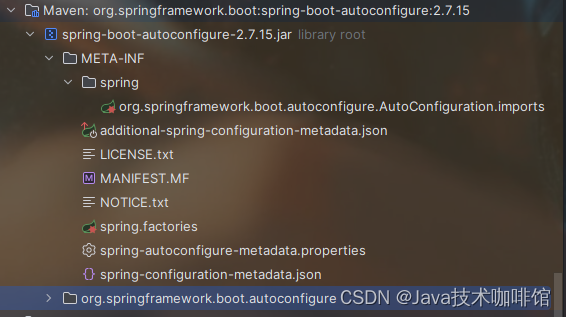

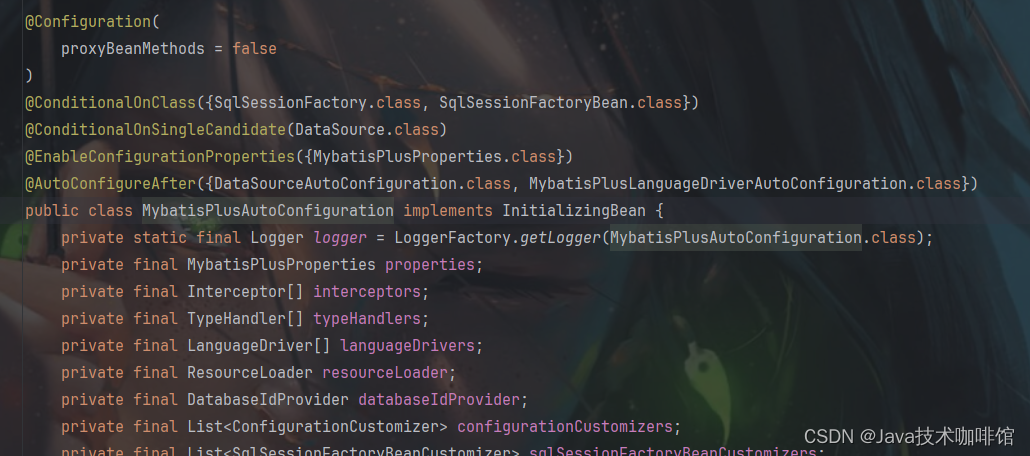
Spring Boot 提供的自动配置类
https://docs.spring.io/spring-boot/docs/current/reference/html/auto-configuration-classes.html#appendix.auto-configuration-classes
Spring Boot 常用条件注解
ConditionalOnBean:是否存在某个某类或某个名字的Bean
ConditionalOnMissingBean:是否缺失某个某类或某个名字的Bean
ConditionalOnSingleCandidate:是否符合指定类型的Bean只有一个
ConditionalOnClass:是否存在某个类
ConditionalOnMissingClass:是否缺失某个类
ConditionalOnExpression:指定的表达式返回的是true还是false
ConditionalOnJava:判断Java版本
ConditionalOnWebApplication:当前应用是不是一个Web应用
ConditionalOnNotWebApplication:当前应用不是一个Web应用
ConditionalOnProperty:Environment中是否存在某个属性
我们也可以使用@Conditional注解进行自定义条件注解

条件注解可以写在类和方法上,如果某个@xxxCondition条件注解写在自动配置类上,那该自动配置类会不会生效就要看当前条件是否符合条件,或者条件注解写在某个@Bean修饰的方法上,那么Bean生不生效也要看当前的条件是否符条件。
Spring容器在解析某个自动配置类时,会先判断该自动配置类上是否有条件注解,如果有,则进一步判断条件注解所指定的条件当前情况是否满足,如果满足,则继续解析该配置类,如果不满足则不进行解析该配置类,于是配置类所定义的Bean也都得不到解析,那么在Spring容器中就不会存在该Bean。
同理,Spring在解析某个@Bean的方法时,也会先判断方法上是否有条件注解,然后进行解析,如果不满足条件,则该Bean也不会生效。
Spring Boot提供的自动配置,实际上就是Spring Boot源码中预先写好准备了一些常用的配置类,预先定义好了一些Bean,在用Spring Boot时,这些配置类就已经在我们项目的依赖中了,而这些自动配置类或自动配置Bean是否生效,就需要看具体指定的条件是否满足。
下面代码就是根据 @Conditional 确定是否应跳过忽略
/*** Determine if an item should be skipped based on {@code @Conditional} annotations.* @param metadata the meta data* @param phase the phase of the call* @return if the item should be skipped*/public boolean shouldSkip(@Nullable AnnotatedTypeMetadata metadata, @Nullable ConfigurationPhase phase) {if (metadata == null || !metadata.isAnnotated(Conditional.class.getName())) {return false;}if (phase == null) {if (metadata instanceof AnnotationMetadata &&ConfigurationClassUtils.isConfigurationCandidate((AnnotationMetadata) metadata)) {return shouldSkip(metadata, ConfigurationPhase.PARSE_CONFIGURATION);}return shouldSkip(metadata, ConfigurationPhase.REGISTER_BEAN);}List<Condition> conditions = new ArrayList<>();for (String[] conditionClasses : getConditionClasses(metadata)) {for (String conditionClass : conditionClasses) {Condition condition = getCondition(conditionClass, this.context.getClassLoader());conditions.add(condition);}}AnnotationAwareOrderComparator.sort(conditions);for (Condition condition : conditions) {ConfigurationPhase requiredPhase = null;if (condition instanceof ConfigurationCondition) {requiredPhase = ((ConfigurationCondition) condition).getConfigurationPhase();}if ((requiredPhase == null || requiredPhase == phase) &&
// 重点判断
!condition.matches(this.context, metadata)) {return true;}}return false;}以@ConditionalOnBean底层工作原理为示例
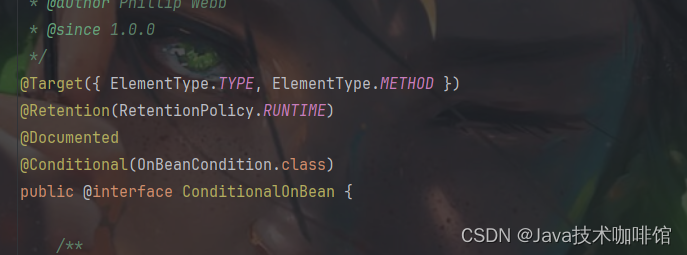
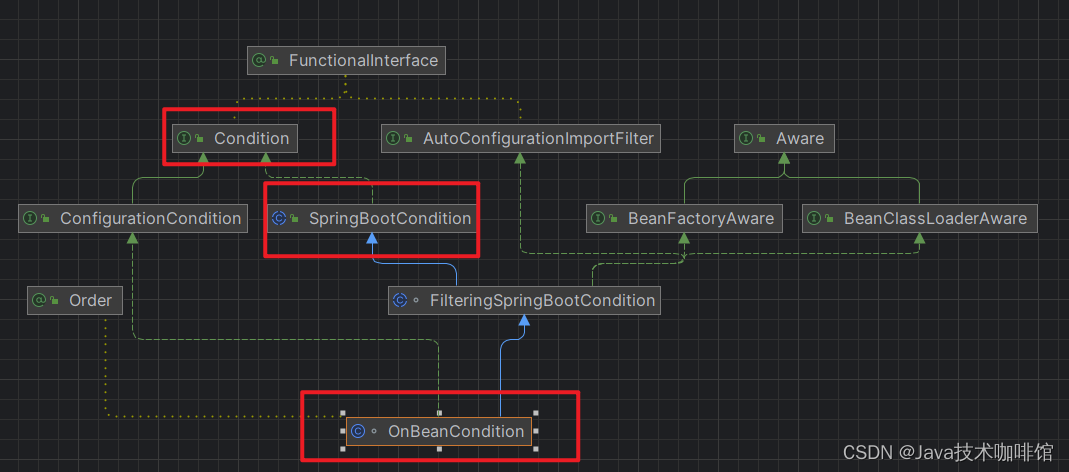
OnBeanCondition类继承了FilteringSpringBootCondition,FilteringSpringBootCondition类又继承SpringBootCondition,而SpringBootCondition实现了Condition接口,matches()方法也是在
SpringBootCondition这个类中实现的:
public abstract class SpringBootCondition implements Condition {private final Log logger = LogFactory.getLog(getClass());@Overridepublic final boolean matches(ConditionContext context, AnnotatedTypeMetadata metadata) {
// 获取当前解析的类名或方法名String classOrMethodName = getClassOrMethodName(metadata);try {
// 进行具体的条件匹配,ConditionOutcome表示匹配结果ConditionOutcome outcome = getMatchOutcome(context, metadata);
//日志记录匹配结果logOutcome(classOrMethodName, outcome);recordEvaluation(context, classOrMethodName, outcome);
// 返回匹配结果 true/falsereturn outcome.isMatch();}catch (NoClassDefFoundError ex) {throw new IllegalStateException("Could not evaluate condition on " + classOrMethodName + " due to "+ ex.getMessage() + " not found. Make sure your own configuration does not rely on "+ "that class. This can also happen if you are "+ "@ComponentScanning a springframework package (e.g. if you "+ "put a @ComponentScan in the default package by mistake)", ex);}catch (RuntimeException ex) {throw new IllegalStateException("Error processing condition on " + getName(metadata), ex);}}
//....public abstract ConditionOutcome getMatchOutcome(ConditionContext context, AnnotatedTypeMetadata metadata);} 具体的条件匹配逻辑在getMatchOutcome方法中实现的,而SpringBootCondition类中的
getMatchOutcome方法是一个抽象方法,具体的实现逻辑就在子类OnBeanCondition:
@Overridepublic ConditionOutcome getMatchOutcome(ConditionContext context, AnnotatedTypeMetadata metadata) {ConditionMessage matchMessage = ConditionMessage.empty();MergedAnnotations annotations = metadata.getAnnotations();// 如果存在ConditionalOnBean注解if (annotations.isPresent(ConditionalOnBean.class)) {Spec<ConditionalOnBean> spec = new Spec<>(context, metadata, annotations, ConditionalOnBean.class);MatchResult matchResult = getMatchingBeans(context, spec);// 如果某个Bean不存在if (!matchResult.isAllMatched()) {String reason = createOnBeanNoMatchReason(matchResult);return ConditionOutcome.noMatch(spec.message().because(reason));}// 所有Bean都存在matchMessage = spec.message(matchMessage).found("bean", "beans").items(Style.QUOTE, matchResult.getNamesOfAllMatches());}// 如果存在ConditionalOnSingleCandidate注解if (metadata.isAnnotated(ConditionalOnSingleCandidate.class.getName())) {Spec<ConditionalOnSingleCandidate> spec = new SingleCandidateSpec(context, metadata, annotations);MatchResult matchResult = getMatchingBeans(context, spec);if (!matchResult.isAllMatched()) {return ConditionOutcome.noMatch(spec.message().didNotFind("any beans").atAll());}Set<String> allBeans = matchResult.getNamesOfAllMatches();if (allBeans.size() == 1) {matchMessage = spec.message(matchMessage).found("a single bean").items(Style.QUOTE, allBeans);}else {List<String> primaryBeans = getPrimaryBeans(context.getBeanFactory(), allBeans,spec.getStrategy() == SearchStrategy.ALL);if (primaryBeans.isEmpty()) {return ConditionOutcome.noMatch(spec.message().didNotFind("a primary bean from beans").items(Style.QUOTE, allBeans));}if (primaryBeans.size() > 1) {return ConditionOutcome.noMatch(spec.message().found("multiple primary beans").items(Style.QUOTE, primaryBeans));}matchMessage = spec.message(matchMessage).found("a single primary bean '" + primaryBeans.get(0) + "' from beans").items(Style.QUOTE, allBeans);}}// 存在ConditionalOnMissingBean注解if (metadata.isAnnotated(ConditionalOnMissingBean.class.getName())) {Spec<ConditionalOnMissingBean> spec = new Spec<>(context, metadata, annotations,ConditionalOnMissingBean.class);MatchResult matchResult = getMatchingBeans(context, spec);if (matchResult.isAnyMatched()) {String reason = createOnMissingBeanNoMatchReason(matchResult);return ConditionOutcome.noMatch(spec.message().because(reason));}matchMessage = spec.message(matchMessage).didNotFind("any beans").atAll();}return ConditionOutcome.match(matchMessage);}protected final MatchResult getMatchingBeans(ConditionContext context, Spec<?> spec) {ClassLoader classLoader = context.getClassLoader();ConfigurableListableBeanFactory beanFactory = context.getBeanFactory();boolean considerHierarchy = spec.getStrategy() != SearchStrategy.CURRENT;Set<Class<?>> parameterizedContainers = spec.getParameterizedContainers();if (spec.getStrategy() == SearchStrategy.ANCESTORS) {BeanFactory parent = beanFactory.getParentBeanFactory();Assert.isInstanceOf(ConfigurableListableBeanFactory.class, parent,"Unable to use SearchStrategy.ANCESTORS");beanFactory = (ConfigurableListableBeanFactory) parent;}MatchResult result = new MatchResult();Set<String> beansIgnoredByType = getNamesOfBeansIgnoredByType(classLoader, beanFactory, considerHierarchy,spec.getIgnoredTypes(), parameterizedContainers);for (String type : spec.getTypes()) {Collection<String> typeMatches = getBeanNamesForType(classLoader, considerHierarchy, beanFactory, type,parameterizedContainers);typeMatches.removeIf((match) -> beansIgnoredByType.contains(match) || ScopedProxyUtils.isScopedTarget(match));if (typeMatches.isEmpty()) {result.recordUnmatchedType(type);}else {result.recordMatchedType(type, typeMatches);}}for (String annotation : spec.getAnnotations()) {Set<String> annotationMatches = getBeanNamesForAnnotation(classLoader, beanFactory, annotation,considerHierarchy);annotationMatches.removeAll(beansIgnoredByType);if (annotationMatches.isEmpty()) {result.recordUnmatchedAnnotation(annotation);}else {result.recordMatchedAnnotation(annotation, annotationMatches);}}for (String beanName : spec.getNames()) {if (!beansIgnoredByType.contains(beanName) && containsBean(beanFactory, beanName, considerHierarchy)) {result.recordMatchedName(beanName);}else {result.recordUnmatchedName(beanName);}}return result;}getMatchingBeans方法中会利用BeanFactory去获取指定类型的Bean,如果没有指定类型的Bean,则会将该类型记录在MatchResult对象的unmatchedTypes集合中,如果有该类型的Bean,则会把该Bean的beanName记录在MatchResult对象的matchedNames集合中,所以MatchResult对象中记录了哪些类没有对应的Bean,哪些类有对应的Bean。
大概流程如下:
Spring在解析某个配置类,或某个Bean定义时如果发现它们上面用到了条件注解,就会取出所有的条件注解,并生成对应的条件对象,比如OnBeanCondition对象;
依次调用条件对象的matches方法,进行条件匹配,看是否符合条件
条件匹配逻辑中,会拿到@ConditionalOnBean等条件注解的信息,判断哪些Bean存在
然后利用BeanFactory来进行判断
最后只有所有条件注解的条件都匹配,那么当前Bean定义才算符合条件生效
自定义Spring Boot Starter
SpringBoot 最强大的功能就是把我们常用的业务场景抽取成了一个个starter(场景启动器),我们通过引入SpringBoot 提供的这些场景启动器,再进行少量的配置就能使用相应的功能。但是,SpringBoot 不能囊括我们所有的业务使用场景,往往我们需要自定义starter,来简化我们对springboot的使用。
下面是自定义starter的示例代码地址:
lp-springboot-start: 自定义Spring Boot Start
